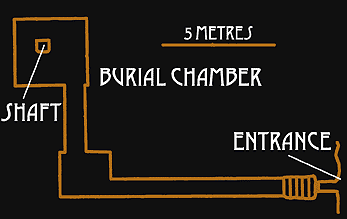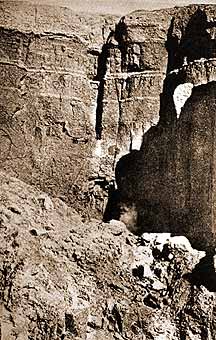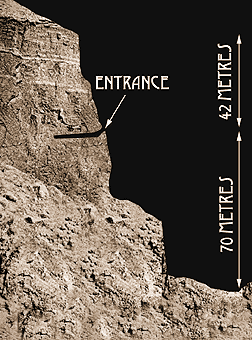 |
Location - Wadi
Sikkat Taka ez-Zeida (approximately one mile to the west of Deir
el-Bahri)
The tomb was built for
the burial of Queen Hatshepsut, at the point this tomb was begun
she was still the wife of Tuthmosis II.
In an attempt to deter
tomb robbers the tomb was built high in the cliffs (see picture
below), but the tomb itself still followed a similar layout to
the tombs that were being prepared in the Valley of the Kings.
|
After passing through
the entrance, a short staircase leads down to a doorway, through
this lead to the first corridor of the tomb, the corridor has
a gentle slope on it at this point. After 10 metres the corridor
leads into an antechamber, a second corridor and then into the
burial chamber (a burial shaft had been cut into the floor of
the burial chamber but had not been finished - the work in the
tomb had halted before any decoration had started (limestone
slabs were found in the tomb, probably intended to have words
and scenes of the Amduat painted on them - similar to the tomb
of Hatshepsut in the Valley of the Kings),
the tomb had not been used for a burial).
 |
|
 |
| |
|
The
positioning of the tomb |
A sarcophagus was found
in the tomb - made of quartzite - which was reminiscent of the
wooden coffins used for the burials of the Queen Ahhotep and
Ahmose Nefertari. The height
of the sarcophagus was impressive; 1.99 metrres (6ft 6").
The sarcophagus was inscribed for Hatshepsut:
"The
Great Princess, great in favour and grace, Mistress of All lands,
Royal Daughter and Royal Sister, Great Royal Wife, Lady of the
Two Lands, Hatshepsut"
The lid
to the sarcophagus (6.5 inches thick) was left standing against
a corner of the sarcophagus, on the lid was a prayer to the goddess
Nut:
"The
King's Daughter, God's Wife, King's Great Wife, Lady of the Two
Lands, Hatshepsut, says 'O my mother Nut, stretch yourself over
me, that you may place me among the imperishable stars which
are in you, and that I may not die".
The Discovery
of the tomb
The tomb
was discovered by Howard Carter in 1916, he had first been alerted
to the fact that tomb robbers had located a previously undiscovered
tomb, Carter and his workmen made their way to this new tomb
during the night, moonlight guiding their way. On reaching the
tomb they discovered a rope leading down the cliffside and could
hear the tomb robbers at work, in Howard Carter's own words:
"Listening,
we could hear the robbers actually at work, so I first severed
their rope, thereby cutting off their means of escape, and then,
making secure a good stout rope of my own, I lowered myself down
the cliff. Shinning down a rope at midnight, into a nestful of
industrious tomb-robbers, is a pastime which at least does lack
excitement. There were eight at work, and when I reached the
bottom there was an awkward moment or two. I gave them the alternative
of clearing out by means of my rope, or else of staying where
they were without a rope at all, and eventually they saw reason
and departed. The rest of the night I spent on the spot, and,
as soon as it was light enough, climbed down into the tomb again
to make a thorough examination."
"The
tomb was discovered full of rubbish ....... this rubbish having
poured into it in torrents from the mountain above. When I wrested
it from the plundering Arabs I found that they had burrowed into
like rabbits, as far as the sepulchral hall ..... I found that
they had crept down a crack extending half way down the cleft,
and there from a small ledge in the rock they had lowered themselves
by rope to the then hidden entrance of the tomb at the bottom
of the cleft: a dangerous performance, but one which I myself
had to imitate, though with better tackle ...... For anyone who
suffers from vertigo it certainly was not pleasant, and though
I soon overcame the sensation of the ascent I was obliged always
to descend in a net".
Carter
then gives voice to this thoughts on the fate of Hatshepsut's
choice of final tomb:
"...
as a king, it was clearly necessary for her to have her tomb
in the Valley of the Kings like all other kings - as a matter
of fact I found it there myself in 1903 - and the present tomb
was abandoned. She would have been better advised to hold to
her original plan. In this secret spot her mummy would have a
reasonable chance of avoiding disturbance: in the Valley it had
none. A king she would be, and a king's fate she shared".
|



